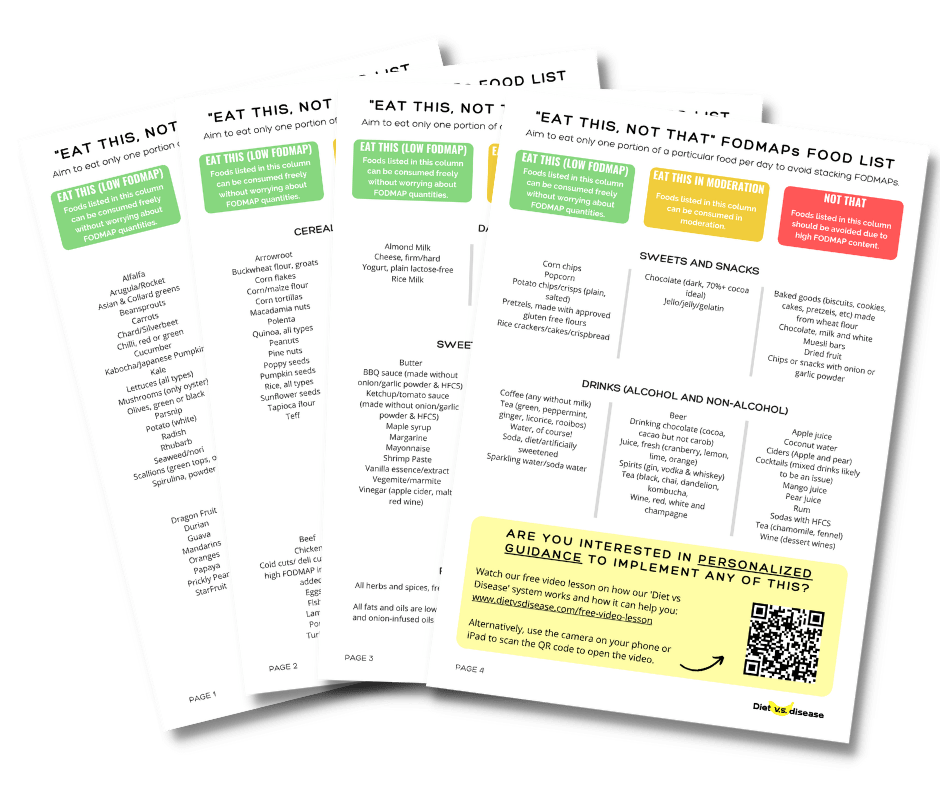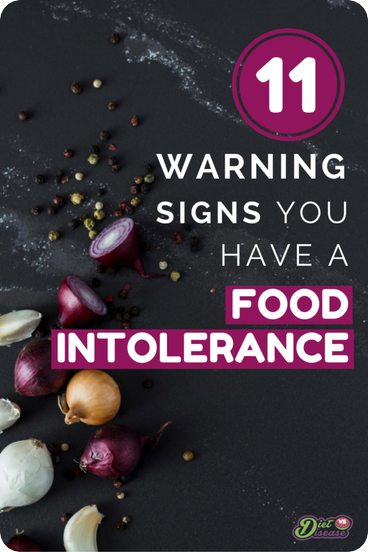Do some foods just not sit right with you?
Have you noticed that it was not just a one-off, but rather part of a trend or pattern of symptoms?
Food intolerance (also known as food sensitivity) is much more common than you think. Up to 10% of people experience it to some degree, yet most don’t do anything about it.
Not to be confused with food allergy (which involves the immune system), a food intolerance reaction occurs when an individual’s threshold to certain food compounds or chemicals is exceeded. Symptoms can occur hours – even days – after eating the offending food.
Scroll through and see if you experience any of the following signs of food intolerance:
1. You’re rushing to the toilet numerous times per day

Do you ever consider not eating somewhere or attending an event where there may not be good bathrooms?
This is quite a common mindset of someone with a strong food intolerance, as the most direct and immediate symptom is digestive stress. This includes things like severe abdominal pain, gas, bloating, and diarrhea– the hallmark of Irritable Bowel Syndrome (IBS).
The main cause of IBS is thought to be fermentable, poorly absorbed carbohydrates known as FODMAPs. The concept of FODMAPs was developed through research at Monash University, and they continue to be the leading authority on the topic.
The only scientifically-proven dietary treatment for IBS is called a Low FODMAP Diet, with a success rate of up to 76% (1).
2. You experience chronic muscle or joint pain that tends to be widespread

Do you suffer from long-term muscle tenderness or joint pain that impacts your day-to-day activities?
Fibromyalgia is a newly-recognised medical condition that affects up to 6% of the population, especially middle-aged women. It is characterised by long-term and widespread pain that is not specific to one particular area (2).
Many fibromyalgia patients report that symtpoms are often triggered by foods they eat. In fact, one study found that almost 50% of those with fibromyalgia reported their symptoms worsened after eating certain foods (3).
Discovering your own food sensitivities, and then cutting down or abstaining completely from those trigger foods, may be the most important thing you can do to treat this condition.
3. Caffeine sends your system into overdrive

It’s no secret that caffeine is a stimulant.
That’s the major reason coffee is the most popular hot beverage in so many countries.
But some of us are caffeine intolerant (myself included). This is because how well your body metabolises caffeine is actually determined by your genes. In fact, with the advances in genetic testing it is now possible to test if you are sensitive to caffeine or not.
For those considered “slow” metabolisers of caffeine, a strong coffee can lead to digestive stress, sweating, raised blood pressure, and potentially even an increased risk of heart disease with regular consumption (4).
Would you like more information on how to resolve food intolerance with a low FODMAP diet?

Tap the blue button below to download our “Eat This, Not That” list as well as additional resources for IBS and digestive issues (it’s free!)
4. You experience frequent headaches or migraines after certain meals

This is quite a common symptom of food intolerance, and largely avoidable when you know what the triggers are.
The most well-known food chemical trigger is Monosodium Glutamate (MSG).
Research shows that those with a sensitivity to dietary glutamate can experience headaches, muscle tightness, numbness/tingling, and weakness after ingesting large amounts (5). Symptoms can take several hours before they hit.
5. You constantly feel exhausted despite sleeping well

Do you often feel exhausted? Not just physically, but mentally and emotionally as well?
Chronic fatigue syndrome is a disorder characterised by severe long-term fatigue that affects a person’s ability to carry out regular everyday activities. It’s estimated that between 1 to 4 million Americans have the condition, yet less than 20% have been diagnosed.
The cause is not well-understood, but food intolerance has long been suspected as a major trigger alongside genetics, inflammation, stress and more. Exploring the best form of treatment is an ongoing process, but diet is likely to play an influential role (6, 7).
6. You don’t tolerate wheat products despite testing negative for celiac disease

Gluten is a protein found in wheat and other grains that is known to cause digestive stress in certain people.
Those with celiac disease have a physiological response to gluten intake, which can be tested for.
But it is thought between 0.5 to 13% of people who don’t have celiac disease still experience difficulties digesting gluten, a condition known as a Non-Celiac Gluten Sensitivity or Gluten Intolerance. While the mechanism is different to celiac disease, the symptoms are thought to be very similar (8).
Based on current evidence, those who do experience a bad reaction to gluten-containing foods (and don’t have celiac disease) should also consider FODMAPs as a trigger for symptoms (9).
7. You have an underactive thyroid (hypothyroidism)

An underactive thyroid (hypothyroidism in a medical context) refers to when the thyroid gland doesn’t produce enough thyroid hormones.
The strong majority of all hypothyroid cases are caused by an autoimmune disease known as Hashimoto’s. Preliminary studies suggest a strong link between Hashimoto’s and an intolerance to gluten (specifically celiac disease). In fact, around 16% of those with celiac disease have antibodies that attack the thyroid (10).
Several studies have also found that a gluten-free diet reduces the number of anti-thyroid antibodies, which is favourable for hypothyroid treatment and in preventing new issues (11, 12).
In other words those with an underactive thyroid may be more likely to have a food intolerance, namely gluten.
8. Milk and yoghurt upset your stomach

Lactose is the natural sugar found in milk. We require the enzyme Lactase to digest it properly.
But it is estimated that 65% of humans experience some difficulty in digesting lactose after infancy, with rates as high as 90% in those of East Asian decent. This is known as lactose intolerance and is one of the most widely-recognised food intolerances.
Reaction severity varies widely depending on the individual, but in most cases it can cause gastrointestinal symptoms similar to IBS.
9. Your rheumatoid arthritis continues to get worse

Unlike osteoarthritis, rheumatoid arthritis (RA) is not caused by standard wear-and-tear.
It’s almost always caused by a combination of genetics and environmental triggers, including diet. Much like with Hashimoto’s and celiac disease, it is thought that an autoimmune response to certain food compounds may trigger symptoms.
The theory is that certain food sensitivities may trigger an inflammatory immune response that prolongs or exacerbates the joint inflammation that causes the pain and swelling in RA patients (13). Note that this is only a theory and has not been proven or disproven .
Considering there is no known cure for RA, and the only dietary supplement that shows any (slim) promise is high-dose fish oil, eliminating the possibility of a food intolerance is a logical phase of treatment.
10. Certain foods give you rashes, eczema or other skin conditions

We usually associate skin reactions with a food allergy because blood tests can supply a reasonable diagnosis for allergies.
But it is now well-understood that food intolerances can cause skin reactions too (such as eczema), albeit a much more delayed response than allergies.
Remember that with food intolerance most can tolerate a reasonable amount of the food compound, but if they eat too much (or too often) then symptoms begin to show.
A natural food chemical called Salicylate is one the biggest culprits when it comes to skin conditions, the other being Histamine. It has been proposed that roughly 2.5% of Europeans have a salicylate sensitivity (14).
While eliminating all salicylates is virtually impossible, limiting the amount consumed to within a tolerable threshold is most effective way to manage it. Tomatoes and peppers (also known as paprika or capsicum) are some stand-out sources of salicylates most commonly reported by patients.
11. You know that a meal rich in onions or garlic gives you gastro

Some of the most common food triggers of digestive stress are onions and garlic.
This is because they are so commonly used to add flavour, yet are also extremely high in FODMAPs. More specifically, both contain fructans that are known triggers in those who are a bit sensitive.
While it’s best to cut them out of your diet during the elimination phase of a low FODMAP diet, there are a few workarounds for flavour, including using garlic-infused oils.
Do you experience any of these warning signs?
If you frequently experience one or more of these warning signs, you should consider trialling a Low FODMAP diet. I suggest you start with this 7-day diet plan.
Would you like more information on how to resolve food intolerance using a low FODMAP diet?

Tap the blue button below to download our “Eat This, Not That” list as well as additional resources for IBS and digestive issues (it’s free!)

